Geminin overexpression promotes imatinib sensitive breast cancer: a novel treatment approach for aggressive breast cancers, including a subset of triple negative
- PMID: 24789045
- PMCID: PMC4005756
- DOI: 10.1371/journal.pone.0095663
Geminin overexpression promotes imatinib sensitive breast cancer: a novel treatment approach for aggressive breast cancers, including a subset of triple negative
Abstract
Breast cancer is the second leading cause of cancer-related deaths in women. Triple negative breast cancer (TNBC) is an aggressive subtype that affects 10-25% mostly African American women. TNBC has the poorest prognosis of all subtypes with rapid progression leading to mortality in younger patients. So far, there is no targeted treatment for TNBC. To that end, here we show that c-Abl is one of several tyrosine kinases that phosphorylate and activate geminin's ability to promote TNBC. Analysis of >800 breast tumor samples showed that geminin is overexpressed in ∼50% of all tumors. Although c-Abl is overexpressed in ∼90% of all tumors, it is only nuclear in geminin overexpressing tumors. In geminin-negative tumors, c-Abl is only cytoplasmic. Inhibiting c-Abl expression or activity (using imatinib or nilotinib) prevented geminin Y150 phosphorylation, inactivated the protein, and most importantly converted overexpressed geminin from an oncogene to an apoptosis inducer. In pre-clinical orthotopic breast tumor models, geminin-overexpressing cells developed aneuploid and invasive tumors, which were suppressed when c-Abl expression was blocked. Moreover, established geminin overexpressing orthotopic tumors regressed when treated with imatinib or nilotinib. Our studies support imatinib/nilotonib as a novel treatment option for patients with aggressive breast cancer (including a subset of TNBCs)-overexpressing geminin and nuclear c-Abl.
Conflict of interest statement
Figures
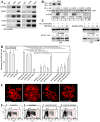
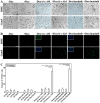
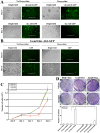

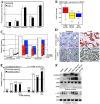
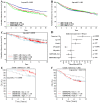

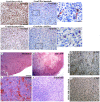


Similar articles
-
Targeting AXL and RAGE to prevent geminin overexpression-induced triple-negative breast cancer metastasis.Sci Rep. 2019 Dec 16;9(1):19150. doi: 10.1038/s41598-019-55702-w. Sci Rep. 2019. PMID: 31844158 Free PMC article.
-
Geminin overexpression-dependent recruitment and crosstalk with mesenchymal stem cells enhance aggressiveness in triple negative breast cancers.Oncotarget. 2016 Apr 12;7(15):20869-89. doi: 10.18632/oncotarget.8029. Oncotarget. 2016. PMID: 26989079 Free PMC article.
-
Immunohistochemical analysis of platelet-derived growth factor receptor-alpha, -beta, c-kit, c-abl, and arg proteins in glioblastoma: possible implications for patient selection for imatinib mesylate therapy.J Neurooncol. 2006 Jan;76(2):105-9. doi: 10.1007/s11060-005-4570-9. J Neurooncol. 2006. PMID: 16205964
-
Pharmacology of imatinib (STI571).Eur J Cancer. 2002 Sep;38 Suppl 5:S28-36. doi: 10.1016/s0959-8049(02)80600-1. Eur J Cancer. 2002. PMID: 12528770 Review.
-
New insights into the pathophysiology of chronic myeloid leukemia and imatinib resistance.Ann Intern Med. 2006 Dec 19;145(12):913-23. doi: 10.7326/0003-4819-145-12-200612190-00008. Ann Intern Med. 2006. PMID: 17179059 Review.
Cited by
-
c-Kit Induces Migration of Triple-Negative Breast Cancer Cells and Is a Promising Target for Tyrosine Kinase Inhibitor Treatment.Int J Mol Sci. 2022 Aug 5;23(15):8702. doi: 10.3390/ijms23158702. Int J Mol Sci. 2022. PMID: 35955836 Free PMC article.
-
Role of the ABL tyrosine kinases in the epithelial-mesenchymal transition and the metastatic cascade.Cell Commun Signal. 2021 May 22;19(1):59. doi: 10.1186/s12964-021-00739-6. Cell Commun Signal. 2021. PMID: 34022881 Free PMC article. Review.
-
Gene expression profile analysis to discover molecular signatures for early diagnosis and therapies of triple-negative breast cancer.Front Mol Biosci. 2022 Dec 7;9:1049741. doi: 10.3389/fmolb.2022.1049741. eCollection 2022. Front Mol Biosci. 2022. PMID: 36567949 Free PMC article.
-
TNBC: Potential Targeting of Multiple Receptors for a Therapeutic Breakthrough, Nanomedicine, and Immunotherapy.Biomedicines. 2021 Jul 23;9(8):876. doi: 10.3390/biomedicines9080876. Biomedicines. 2021. PMID: 34440080 Free PMC article. Review.
-
ABL kinases promote breast cancer osteolytic metastasis by modulating tumor-bone interactions through TAZ and STAT5 signaling.Sci Signal. 2016 Feb 2;9(413):ra12. doi: 10.1126/scisignal.aad3210. Sci Signal. 2016. PMID: 26838548 Free PMC article.
References
-
- McGarry T, Kirschner M (2011) Geminin, an inhibitor of DNA replication, is degraded during mitosis. Cell 93(6): 1043–5321. - PubMed
-
- Wohlschlegel J, Dwyer B, Dhar S, Cvetic C, Walter J, et al. (2000) Inhibition of eukaryotic DNA replication by geminin binding to Cdt1. Science 290: 2309–2312. - PubMed
-
- Thépaut M, Maiorano D, Guichou J, Augé M, Dumas C, et al. (2004) Crystal structure of the coiled-coil dimerization motif of geminin: structural and functional insights on DNA replication regulation. J Mol Biol 342(1): 275–287. - PubMed
-
- Kroll K, Salic A, Evans L, Kirschner M (1998) Geminin, a neutralizing molecule that demarcates the future neural plate at the onset of gastrulation. Development 125: 3247–3258. - PubMed
-
- Del Bene F, Tessmar-Raible K, Wittbrodt J (2004) Direct interaction of geminin and Six3 in eye development. Nature 427: 745–749. - PubMed
Publication types
MeSH terms
Substances
Grants and funding
LinkOut - more resources
Full Text Sources
Other Literature Sources
Molecular Biology Databases
Research Materials
Miscellaneous

